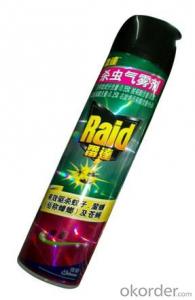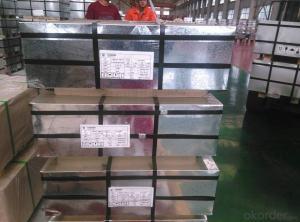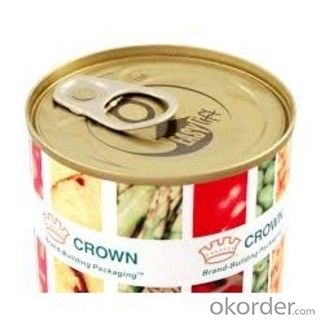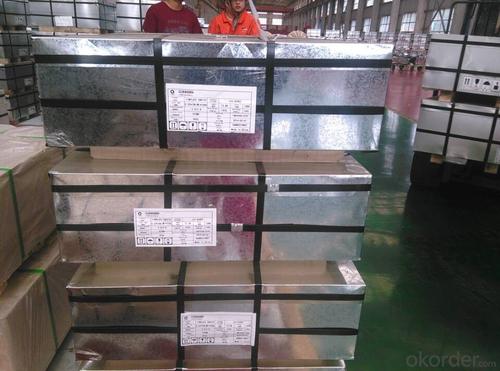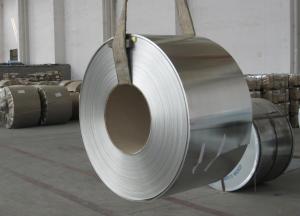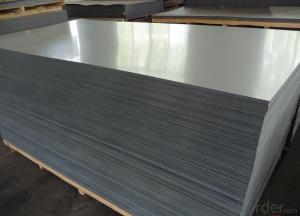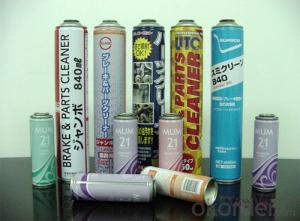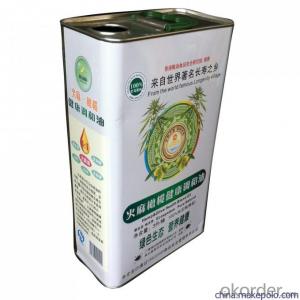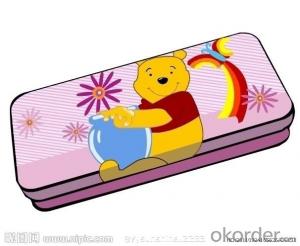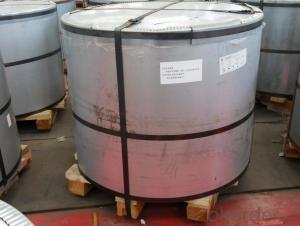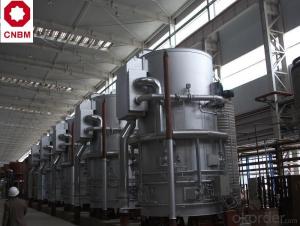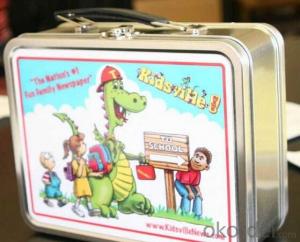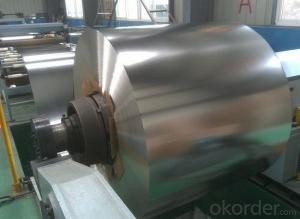Tinplate Sheets For Canned Fish Cans, CA, T57 Temper
- Loading Port:
- Tianjin
- Payment Terms:
- TT OR LC
- Min Order Qty:
- 50 m.t.
- Supply Capability:
- 40000 m.t./month
OKorder Service Pledge
OKorder Financial Service
You Might Also Like
1.Usage
Tinplate is widely used for making all types of containers, containing industrial usage such as paint can, oil can, aerosol cans etc., and food cans like milk powder cans, tomato paste can, dry food cans etc.
2. Quality
As a state owned company and a large tinplate supplier in China, our tinplate quality ranks 1st level in China, similar to Bao Steel, Posco etc.
3. Specification
standard: GB/T2520, JIS G3303, DIN EN10202
Material: MR /SPCC
Thickness available: 0.16-0.50MM
Width available: 600~1050MM
Temper grade: T1 – DR8
Tin coating: ordinary 2.8g/2.8g, 5.6g/5.6g and others
Package: sea worthy export package.
Applications: Tin can for chemicals & paint cans, industrial cans, food cans
4. Our factory photo & equipments

5. Our Markets:
now our tinplate has been sold to more than 50 countries, including Europe country, Gulf Area, South American, South Afric etc.
6. Our Overseas Wareouses:
Furthermore, in the year 2014, we have more than 10 overseas warehouses all over the word, located in KSA, UAE, Oman, Russia, Kuwait, Qatar, Oman, Chile, Brazil etc.
7. FAQ
a. what's the annual output?
about 500,000 tons per year.
b. where's the raw matrial from?
our hot rolled coil is purchased from Capital Steel and other state owned mill, with quite good quality.
c. how long is the delivery time?
normally for SPCC about 45~55 days, while 65~75 days for MR material
d. how to control the quality during production process?
inside our workshop, we have MES syestem. It realizes the optimization of the production procedure in the workshop. It could record each step of the whole production procedures, and if some problem appears, factory could easily found and take action, it’s quite helpful to monitor and control the quality.
- Q: Is tinplate recyclable?
- Yes, tinplate is recyclable.
- Q: What are the advantages of using tinplate for pharmaceutical packaging?
- There are several advantages of using tinplate for pharmaceutical packaging. Firstly, tinplate is highly resistant to corrosion, ensuring the integrity and safety of the pharmaceutical products. Secondly, tinplate provides excellent barrier properties, protecting the contents from moisture, light, and oxygen, which can degrade the quality and efficacy of medications. Additionally, tinplate is sturdy and durable, providing adequate protection during transportation and storage. Finally, tinplate is easily recyclable, making it an environmentally friendly choice for pharmaceutical packaging.
- Q: What are the main challenges in tinplate coating?
- The main challenges in tinplate coating include achieving consistent and uniform coating thickness, ensuring adhesion between the tin layer and the substrate, preventing corrosion and oxidation of the tin layer, and minimizing the formation of defects such as pinholes, blisters, and wrinkles. Additionally, challenges arise in maintaining the desired surface finish, controlling the tin coating composition, and improving the overall efficiency and cost-effectiveness of the coating process.
- Q: How can recycled tin cans be recycled?
- The broken material is separated by the air whirling sorting system, and the metal and nonmetal are separated from each other. Moreover, the whole system is equipped with a dust removing device to minimize the damage caused by dust pollution in the process of production.Tin tins, crushing machines, equipment and maintenance costs are low: equipment design is reasonable, well made, extending the service life of equipment, reducing the use and maintenance costs of equipment.
- Q: What are the main factors influencing the demand for tinplate?
- The main factors influencing the demand for tinplate include the growth of the packaging industry, technological advancements in tinplate manufacturing, consumer preferences for sustainable and recyclable packaging materials, government regulations on food safety and product packaging, and the economic growth and urbanization in emerging markets.
- Q: How does tinplate packaging contribute to product protection against light?
- Tinplate packaging contributes to product protection against light by providing a highly effective barrier that prevents light from reaching the product. The tin coating on the steel substrate acts as a reflective layer, reducing the amount of light transmission. This helps to shield the product from harmful UV radiation and other forms of light that can cause degradation, discoloration, or spoilage. Additionally, tinplate packaging can be further enhanced with additional protective coatings or lacquers that provide an additional layer of defense against light exposure, ensuring the product remains intact and protected.
- Q: Can tinplate be used for cooking utensils?
- No, tinplate is not suitable for cooking utensils as it can contaminate food with harmful substances.
- Q: How does tinplate ensure the freshness of pet food?
- Tinplate ensures the freshness of pet food by providing a durable and airtight packaging solution. The tin coating on the steel sheet prevents any reaction between the metal and the pet food, keeping it safe from contamination. The hermetically sealed tinplate cans also protect the food from exposure to oxygen, light, and moisture, which can lead to spoilage. This ensures that the pet food remains fresh and maintains its quality for a longer shelf life.
- Q: How is tinplate used in the manufacturing of kitchenware?
- Tinplate is commonly used in the manufacturing of kitchenware as it provides a protective coating on steel products, preventing corrosion and extending their lifespan. This coating of tin also enhances the appearance of kitchenware, making it more visually appealing. Additionally, tinplate offers a non-reactive surface, ensuring that food does not get contaminated by the metal it comes in contact with. Therefore, tinplate is widely utilized for various kitchenware items like cans, containers, cookware, and utensils.
- Q: What are the different ways to label tinplate closures?
- There are several different ways to label tinplate closures. One common method is using pressure-sensitive labels that can be applied directly onto the closure. Another option is to use direct printing techniques such as screen printing or pad printing to add the required information onto the closure. Additionally, some closures may be embossed or debossed with branding or text, providing a more permanent labeling solution.
Send your message to us
Tinplate Sheets For Canned Fish Cans, CA, T57 Temper
- Loading Port:
- Tianjin
- Payment Terms:
- TT OR LC
- Min Order Qty:
- 50 m.t.
- Supply Capability:
- 40000 m.t./month
OKorder Service Pledge
OKorder Financial Service
Similar products
Hot products
Hot Searches
Related keywords
